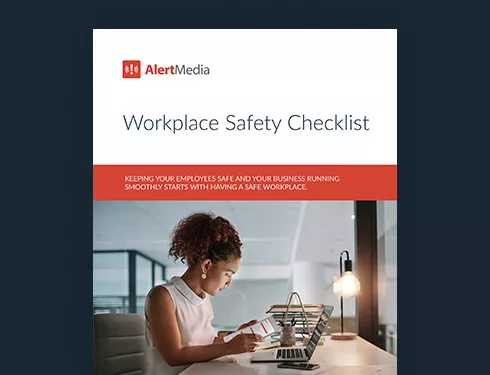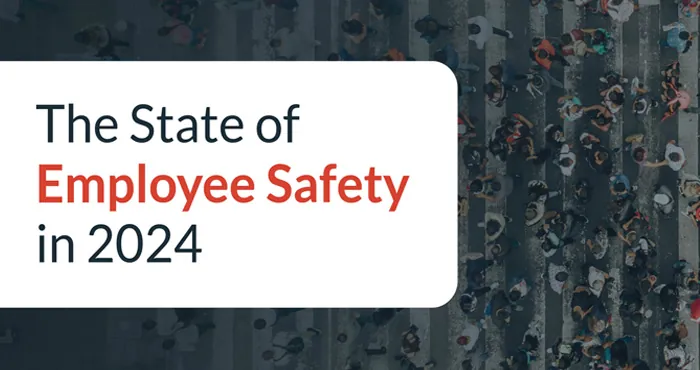
How to Avoid the Top 10 OSHA Violations in the Workplace
OSHA violations aren’t there to make your life difficult; they’re derived from hard-learned lessons and are meant to prevent further tragedy. Learn how to stay on OSHA’s good side and protect your employees from these top 10 safety violations.

There was a time when workers weren’t protected. Left unregulated, some employers subjected their workers to unsafe machines, toxic chemicals, and other harsh labor conditions that led to high rates of workplace injuries and deaths, even among children. As industrial production rose after WWII, so did accidents and exposure to new chemicals. With that, disabling injuries increased by a steep 20% during the 1960’s, with 14,000 workers dying on the job each year.
Thankfully, federal law now requires employers to provide a safe workplace. In response to public concern about rising numbers of deaths and injuries on the job, Congress established the Occupational Safety and Health Administration (OSHA) in 1970. As a permanent agency within the U.S. Department of Labor, OSHA’s purpose and mission is to oversee safety in the workplace. The OSHA office is in charge of setting and enforcing workplace safety and health standards and making sure all employees are aware of their rights.

The most important of these standards is the “General Duty Clause,” which states, “Each employer shall furnish to each of [its] employees employment and a place of employment which are free from recognized hazards that are causing or are likely to cause death or serious physical harm to [its] employees.” This requirement formalizes the concept of duty of care, and it applies to any kind of business, as illustrated in our post, which covers seven examples of duty of care.
Safety should be the first priority for every company. Understanding your responsibility as an employer and knowing the workplace hazards that exist around your offices, equipment, and machinery will go a long way in preventing serious injuries or even death at your place of business.
Here’s what you need to know about OSHA violations, how they work, and the potential consequences to your business.
Download Our Workplace Safety Checklist
What Are OSHA Violations?
An OSHA violation occurs when a business or its employees don’t comply with a certain regulation for keeping the workplace free of serious hazards. OSHA violations range from minor, such as a technical infraction that poses no immediate danger, to serious dangers and health threats like unsafe wiring or poor ventilation.
There are six types of OSHA violations, categorized as:
- De minimis
- Other-than-serious
- Failure to abate
- Serious
- Willful
- Repeated
The main way OSHA enforces its regulations and standards is through inspections. OSHA inspections are conducted based on the following order of priority:
Situations that could cause death or serious physical harm
Employers must report all work-related fatalities and serious injuries within a specific timeframe and undergo an inspection
Workers can anonymously ask OSHA to inspect their workplace if they believe their employer is ignoring serious safety hazards or not complying with OSHA standards
From other government agencies, individuals, organizations, or the media
Aimed at high-risk industries or individual employers with high rates of injuries and illnesses
To make sure previous violations have been corrected
If an inspector sees violations or serious safety risks at your worksite, OSHA may issue citations and fines. Citations will include a description of the specific OSHA safety requirements allegedly violated, any proposed penalties, and a deadline for correcting the reported hazards.
Penalties for violating OSHA safety standards vary based on the severity of the violation. Serious violations will receive a maximum penalty of $15,625, while willful infringements or repeated violations can cost the business a maximum fine of $156,259 per violation.
Don’t Be Complacent About Office Safety
Some business owners may think safety can be a distant focus because their office has two steps to the parking lot, tons of carpet, and no equipment more complex than a drip coffee maker. Isn’t OSHA concerned with factories and industrial sites filled with heavy machinery and equipment where the focus is on manual labor?
Not so fast! OSHA has jurisdiction over approximately 7 million worksites, covering most of the private sector and some of the public sector. OSHA regulations cover employers and workers in the 50 states as well as certain territories under federal authority.
What’s more—fall risks, chemical exposure, and other hazards can occur in any office environment, no matter how climate-controlled and cushy. So, regardless of which office location you find yourself in, employee safety should always take precedence.
OSHA safety topics
Staying on top of the host of OSHA regulations that apply to your business can be quite a challenge. One approach is to hold regular “refresher” sessions to keep important information top-of-mind. These targeted safety meetings are generally brief and can be geared to small or large groups, depending on how the information applies to different roles and work environments. Looking for some specific meeting topics to run for your people? You’re in luck with our OSHA Safety Topics post!
Top 10 OSHA Violations for 2023
OSHA publishes an annual list of its most frequently cited violations in the workplace. By examining this list, employers can analyze the dangers inherent in their workplaces and plan to avoid them. Each of these hazards may not apply to every business, so take an all-hazards approach to plan for the primary risks facing your company. Here are the most common OSHA violations for Fiscal Year (FY) 2023 and their associated standard numbers:
1. Fall protection (1926.501) — 7,271 violations
Falls are one of the leading causes of serious injury and death at work. So, it’s no surprise to see that plenty of workplaces don’t quite nail this one. OSHA covers some of the ways the workplace can be set up to prevent employees from falling off of overhead platforms, elevated workstations, or into holes in the floor and walls, including:
- Guarding every floor hole with covers, railings, and/or toe-boards
- Using guardrails and toe-boards near all elevated open-sided platforms, floors, and runways, or near dangerous machines or equipment
- Keeping floors clean and dry
- Using additional means of fall protection when necessary, such as safety harness and fall arrest system, safety nets, stair railings, and handrails
2. Hazard communication (1910.1200) — 3,213 violations
An informed employee is a safe employee. At a minimum, companies must inform their employees about the identities and hazards of chemicals in the workplace. OSHA’s rules require chemical manufacturers and importers to prepare labels and safety data sheets that clearly communicate the hazard to their customers. All employers with hazardous chemicals in their workplaces must also:
- Provide labels and safety data sheets for all exposed workers
- Train workers to handle chemicals appropriately
- Inform and train workers on how to read and understand label elements and safety data sheets
In addition, switching to safer chemicals and providing protective equipment (PPE) like masks and gloves will help keep your workplace and your people safer.
Chemical safety is no joke. It’s critical to communicate about hazards easily and quickly to keep workers safe, informed, and connected.
3. Ladders (1926.1053) — 2,978 violations
Everyone knows how to climb a ladder safely, right? Ladders are so common that many people take them for granted. Nevertheless, OSHA inspectors cited 2,978 violations of ladder safety protocol in FY 2023. With various ladders in the workplace (job made, self-supporting portable ladder, not self-supporting portable ladder, etc.), businesses need to know the standards to keep employees safe when they climb. For example:
- Ladders must be able to support at least the maximum intended load
- Ladders should not be used on slippery, unstable, and unlevel surfaces
- Rungs should have skid-resistant material on them to minimize slipping
- Ladder rungs, cleats, or steps should be parallel, level, and uniformly spaced
- Additional safety measures, like self-retracting lifelines, cages, or wells, should be used for higher climbs
4. Scaffolding (1926.451) — 2,859 violations
OSHA estimates that 2.3 million construction workers (65% of the construction industry) labor on scaffolds during a typical day. Soberingly, one in five workplace fatalities is a construction worker.
However, with a proper safety and health plan, construction can be a safe occupation. OSHA’s complex standards for scaffolds may prevent 4,500 injuries and more than 60 deaths per year. For employers, that means a lot fewer missed days of work and lower safety costs. Common safety and non-compliance concerns to avoid are:
- Platforms or planking with less-than-permissible spans, rated load capacity, or thickness
- Scaffolds cluttered with debris or materials that impose a tripping hazard
- Lack of safety measures like guardrails and cross bracing
OSHA’s Scaffolding eTool helps employers prevent violations and minimize tragic workplace accidents. The free tool outlines common hazards, requirements, and accident prevention tactics. It also includes illustrated safety checklists for certain types of scaffolds.
5. Powered industrial trucks (1910.178) — 2,561 violations
Business owners, you know you have a “powered industrial truck” if you operate a forklift or lift truck to move materials. Not surprisingly, OSHA has a long list of standards for these ubiquitous—and potentially dangerous—vehicles.
OSHA’s standards for powered industrial trucks include general requirements related to fire protection, design, maintenance, and use of all types of specialized industrial trucks. Here are a few more resources from the OSHA website for business leaders who are concerned with workplace safety and OSHA compliance:
6. Lockout-Tagout (1910.147) — 2,554 violations
Maintaining heavy equipment and machinery is necessary for businesses but carries risk. If not properly shut off, dangerous machines could start up again during repair or maintenance. Violations of lockout/tagout experienced a relative increase from FY 2021 to 2022, moving it up from position seven to six on OSHA’s most-cited violations list, where it remained again for FY 2023.
The lockout-tagout (LOTO), or lock and tag, is a safety procedure used in industry and research settings. With LOTO, hazardous energy sources are “isolated and rendered inoperative” before a worker starts to operate the equipment in question. The isolated power sources are then locked and a tag is placed on the lock identifying the worker who placed it. The worker then holds the key for the lock ensuring that only he or she can remove the lock and start the machine.
Injuries from hazardous energy during maintenance activities (such as hot steam or electrical shock) can be serious or fatal. Thus, business leaders need to develop, implement, and enforce an effective tagout program, including training to ensure that employees know and understand specific energy control procedures.
7. Respiratory protection (1910.134) — 2,481 violations
Respiratory protection fell from the #2 spot on OSHA’s ‘most cited’ list in FY 2021 (2,527 violations) to #3 in FY 2022 (2,185 violations). In FY 2023, it fell significantly all the way to #7, even as the total number of citations increased YoY.
If your workers labor in hazardous conditions, respirators are among the most vital pieces of protective, possibly lifesaving equipment you can offer these employees. OSHA guidelines call for workers to use a respirator or a device that protects them from inhaling dangerous substances, such as chemicals and infectious particles.
The employer is responsible for selecting and providing an appropriate respirator based on the type(s) of respiratory hazards employees may be exposed to. You can also use other controls to prevent atmospheric contamination, such as central and local ventilation, substitution for non-toxic materials, and other personal protective equipment such as masks.
8. Fall protection—training requirements (1926.503) — 2,112 violations
We’ve already seen that fall protection is a big area of improvement for employers as they seek to protect their workforce. But did you know that fall protection training is also an area that trips up employers?
OSHA guidelines state: “The employer shall provide a training program for each employee who might be exposed to fall hazards. The program shall enable each employee to recognize the hazards of falling and shall train each employee in the procedures to be followed in order to minimize these hazards.” For a full list of fall safety procedures, see OSHA’s website.
Do you need to communicate with employees about necessary safety training but find it hard to contact them in the field? An employee notification system might be the answer for your organization, with two-way messaging and multiple channels such as voice, text, Slack, and email.
9. Eye and face protection (1926.102) — 2,074 violations
Eye and face protection OSHA violations ranked #9 in FY 2022 with 1,401 total violations and remained in that spot once again in FY 2023. OSHA reports that eye injuries cost businesses more than $300 million per year in lost production time, medical expenses, and worker compensation.
Preventing blindness and other eye injuries is the goal of OSHA’s eye and face protection standards for general industry, shipyard employment, longshoring, and construction. The standards address personal protection, special subparts for welding, cutting, and brazing (for example), and many other items.
Provide eye and face protection whenever necessary to protect against chemical, environmental, radiological, or mechanical irritants and hazards. Require fit testing to ensure proper function. If you need help determining potential hazards on the job and choosing specific eye and face protection, this OSHA web page is a good first stop.
10. Machine guarding (1910.212) — 1,644 violations
We’re not surprised to see machine guarding make the list of top violations. The standards for machine guarding are quite complex. The purpose of machine guarding is to protect the machine operator and other employees from injuries created by ingoing nip points, rotating parts, flying chips, and sparks. OSHA machine guarding violations increased from 1,113 in FY 2021 to 1,370 in FY 2022 to 1,644 in FY 2023.
To help protect workers and curb injuries, OSHA publishes resources on hazard recognition and possible solutions for machine guarding dangers, including safeguarding techniques, best practices, and virtual tours of select machines.
Creating Inviolable Standards
After reading this list, you might be feeling a bit overwhelmed. But each of these risks is avoidable if you act with the proper precautions. And you have a legal and ethical responsibility to take the necessary precautions to provide safe working conditions.
If you’re concerned about potential safety violations at your workplace, consider conducting a workplace safety audit, refreshing employee training, or even designating an OSHA compliance officer who can keep the company accountable to safety initiatives.
A modern emergency communication system such as AlertMedia can also help you communicate required information with employees and adhere to recordkeeping requirements related to hazard communication and safety policies to avoid potential OSHA citations. Are your workers often alone in fall risk zones? If so, a lone worker safety solution can ensure that your employees are always covered, even when they are by themselves on the job. And software like AlertMedia which combines mass notification capabilities, mobile app access, and 24/7 monitoring offers improved employee protection and will help you respond to workplace emergencies faster.
OSHA standards are nothing if not comprehensive—and as an employer, you’re obliged to follow them. Employees trust their employers are doing everything they can to keep them safe. By following OSHA guidelines to the letter in your safety program, you can do that, fulfilling your duty of care.




